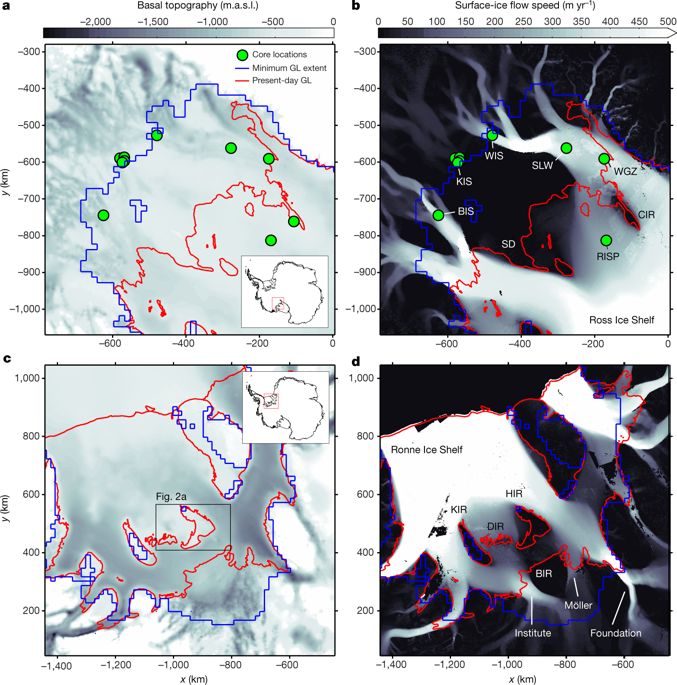Our official English website, www.x-mol.net, welcomes your feedback! (Note: you will need to create a separate account there.)
Extensive retreat and re-advance of the West Antarctic Ice Sheet during the Holocene
Nature ( IF 64.8 ) Pub Date : 2018-06-01 , DOI: 10.1038/s41586-018-0208-x J. Kingslake , R. P. Scherer , T. Albrecht , J. Coenen , R. D. Powell , R. Reese , N. D. Stansell , S. Tulaczyk , M. G. Wearing , P. L. Whitehouse
Nature ( IF 64.8 ) Pub Date : 2018-06-01 , DOI: 10.1038/s41586-018-0208-x J. Kingslake , R. P. Scherer , T. Albrecht , J. Coenen , R. D. Powell , R. Reese , N. D. Stansell , S. Tulaczyk , M. G. Wearing , P. L. Whitehouse

|
To predict the future contributions of the Antarctic ice sheets to sea-level rise, numerical models use reconstructions of past ice-sheet retreat after the Last Glacial Maximum to tune model parameters1. Reconstructions of the West Antarctic Ice Sheet have assumed that it retreated progressively throughout the Holocene epoch (the past 11,500 years or so)2–4. Here we show, however, that over this period the grounding line of the West Antarctic Ice Sheet (which marks the point at which it is no longer in contact with the ground and becomes a floating ice shelf) retreated several hundred kilometres inland of today’s grounding line, before isostatic rebound caused it to re-advance to its present position. Our evidence includes, first, radiocarbon dating of sediment cores recovered from beneath the ice streams of the Ross Sea sector, indicating widespread Holocene marine exposure; and second, ice-penetrating radar observations of englacial structure in the Weddell Sea sector, indicating ice-shelf grounding. We explore the implications of these findings with an ice-sheet model. Modelled re-advance of the grounding line in the Holocene requires ice-shelf grounding caused by isostatic rebound. Our findings overturn the assumption of progressive retreat of the grounding line during the Holocene in West Antarctica, and corroborate previous suggestions of ice-sheet re-advance5. Rebound-driven stabilizing processes were apparently able to halt and reverse climate-initiated ice loss. Whether these processes can reverse present-day ice loss6 on millennial timescales will depend on bedrock topography and mantle viscosity—parameters that are difficult to measure and to incorporate into ice-sheet models.Radiocarbon dating of sediment cores and ice-penetrating radar observations are used to demonstrate that the West Antarctic Ice Sheet has not retreated progressively during the Holocene epoch, but has instead showed periods of retreat and re-advance.
中文翻译:

全新世期间南极西部冰盖的广泛退缩和重新前进
为了预测南极冰盖对海平面上升的未来贡献,数值模型使用对末次盛冰期后过去冰盖退缩的重建来调整模型参数1。南极西部冰盖的重建假设它在整个全新世(过去 11,500 年左右)2-4 中逐渐退缩。然而,在这里我们表明,在此期间,南极西部冰盖的接地线(标志着它不再与地面接触并成为一个漂浮的冰架的点)在今天的接地内陆后退了数百公里线,在均衡反弹导致它重新前进到目前的位置之前。我们的证据包括,首先,对从罗斯海区冰流下回收的沉积物核心进行放射性碳测年,表明广泛的全新世海洋暴露;第二,威德尔海区冰期结构的穿冰雷达观测,表明冰架接地。我们用冰盖模型探索这些发现的含义。全新世接地线的模拟重新推进需要由等静压回弹引起的冰架接地。我们的研究结果推翻了在南极洲西部全新世期间接地线逐渐后退的假设,并证实了先前关于冰盖重新前进的建议 5。反弹驱动的稳定过程显然能够阻止和逆转气候引发的冰损失。
更新日期:2018-06-01
中文翻译:

全新世期间南极西部冰盖的广泛退缩和重新前进
为了预测南极冰盖对海平面上升的未来贡献,数值模型使用对末次盛冰期后过去冰盖退缩的重建来调整模型参数1。南极西部冰盖的重建假设它在整个全新世(过去 11,500 年左右)2-4 中逐渐退缩。然而,在这里我们表明,在此期间,南极西部冰盖的接地线(标志着它不再与地面接触并成为一个漂浮的冰架的点)在今天的接地内陆后退了数百公里线,在均衡反弹导致它重新前进到目前的位置之前。我们的证据包括,首先,对从罗斯海区冰流下回收的沉积物核心进行放射性碳测年,表明广泛的全新世海洋暴露;第二,威德尔海区冰期结构的穿冰雷达观测,表明冰架接地。我们用冰盖模型探索这些发现的含义。全新世接地线的模拟重新推进需要由等静压回弹引起的冰架接地。我们的研究结果推翻了在南极洲西部全新世期间接地线逐渐后退的假设,并证实了先前关于冰盖重新前进的建议 5。反弹驱动的稳定过程显然能够阻止和逆转气候引发的冰损失。



























 京公网安备 11010802027423号
京公网安备 11010802027423号